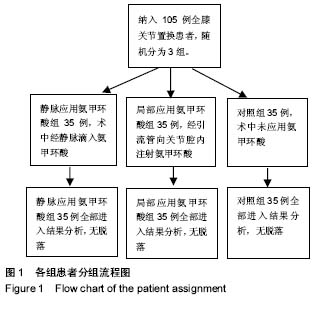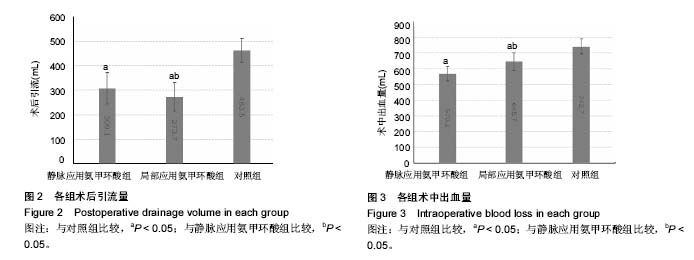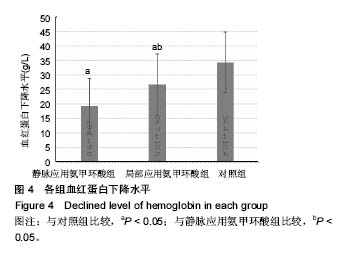| [1] Panteli M, Papakostidis C, Dahabreh Z, et al. Topical tranexamic acid in total knee replacement: a systematic review and meta-analysis. Knee. 2013;20(5):300.[2] Spahn DR, Casutt M. Eliminating blood transfusions: new aspects and perspectives. Anesthesiology. 2000;93(1): 242-255.[3] Dunn CJ, Goa KL. Tranexamic acid: a review of its use in surgery and other indications. Drugs. 1999,57(6): 1005-1032. [4] Soliman R, Yousef H, Alghadam F, et al. Prospective, Randomized, comparative study between aprotinin and tranexamic acid in cardiac surgery. J Anesthes Clin Res. 2013;2(1):201-205.[5] Calamari D, Zuccato E, Castiglioni S, et al. Strategic survey of therapeutic drugs in the Rivers Po And Lambro in northern Italy. Env Scie Technol. 2015;37(7):1241-1248.[6] Sanz-Reig J, Parra RB, Ferrández MJ, et al. Single intravenous tranexamic acid dose to reduce blood loss in primary total knee replacement. Rev Esp Cir Ortop Traumatol. 2016;60(2):106-112. [7] Chen JY, Chin PL, Moo IH, et al. Intravenous versus intra-articular tranexamic acid in total knee arthroplasty: A double-blinded randomised controlled noninferiority trial. Knee. 2016;23(1):152-156. [8] Gillette BP, Desimone LJ, Trousdale RT, et al. Low risk of thromboembolic complications with tranexamic acid after primary total hip and knee arthroplasty. Clin Orthop Relat Res. 2013;471(1):150-154.[9] Hynes M, Calder P, Scott G. The use of tranexamic acid to reduce blood loss during total knee arthroplasty. Knee. 2003; 10(4):375-377.[10] Kagoma YK, Crowther MA, Douketis J, et al. Use of antifibrinolytic therapy to reduce transfusion in patients undergoing orthopedic surgery: a systematic review of randomized trials. Thromb Res. 2009;123(5):687.[11] Madsen RV, Nielsen CS, Kallemose T, et al. Low risk of thromboembolic events after routine administration of tranexamic acid in hip and knee arthroplasty. J Arthroplasty. 2017;32(4):1298-1303. [12] Zhu M, Chen JY, Yew AK, et al. Intra-articular tranexamic acid wash during bilateral total knee arthroplasty. J Orthop Surg (Hong Kong). 2015;23(3):290-293. [13] May JH, Rieser GR, Williams CG, et al. The assessment of blood loss during total knee arthroplasty when comparing intravenous vs intracapsular administration of tranexamic acid. J Arthroplasty. 2016;31(11):2452-2457.[14] Sun Q, Yu X, Nie X, et al. The efficacy comparison of tranexamic acid for reducing blood loss in total knee arthroplasty at different dosage time. J Arthroplasty. 2017; 32(1):33-36. [15] Shin YS, Yoon JR, Lee HN, et al. Intravenous versus topical tranexamic acid administration in primary total knee arthroplasty: a meta-analysis. Knee Surg Sports Traumatol Arthrosc. 2016;23(105):1-11.[16] Sadigursky D, Andion D, Boureau P, et al. Effect of tranexamic acid on bleeding control in total knee arthroplasty. Acta Ortop Bras. 2016;24(3):131-136. [17] Digas G, Koutsogiannis I, Meletiadis G, et al. Intra-articular injection of tranexamic acid reduce blood loss in cemented total knee arthroplasty. Eur J Orthop Surg Traumatol. 2015; 25(7):1181-1188.[18] Vijay BS, Vikram B, Subhro M, et al. Role of tranexamic acid in reducing postoperative blood loss and transfusion requirement in patients undergoing hip and femoral surgeries. Saudi J Anaesth. 2013;7(1):29-32.[19] Rasouli MR, Parvizi J. Tranexamic Acid in total joint arthroplasty: efficacy and safety. Arch Bone Joint Surg. 2015; 3(1):1.[20] Aglietti P, Baldini A, Vena LM, et al. Effect of tourniquet use on activation of coagulation in total knee replacement. Clin Orthop Relat Res. 2000;371(371):169.[21] Darina DCL, Pablo MH, Flores YN, et al. Influence of mealtime habits on the risk of weight gain and obesity in Mexican adults. Public Health Nutr. 2016;20(2):220-232.[22] Wong J, Abrishami A, El BH, et al. Topical application of tranexamic acid reduces postoperative blood loss in total knee arthroplasty: a randomized, controlled trial. J Bone Joint Surg Am. 2010;92(15):2503.[23] Hirotaka M, Kotaro I. Intra-articular injection of tranexamic acid via a drain plus drain-clamping to reduce blood loss in cementless total knee arthroplasty. J Orthop Surg Res. 2012; 7(1):1-6.[24] Irwin A, Khan SK, Jameson SS, et al. Oral versus intravenous tranexamic acid in enhanced-recovery primary total hip and knee replacement: results of 3000 procedures. Bone Joint J. 2013;95-B(11):1556.[25] Pongcharoen B, Ruetiwarangkoon C. Does tranexamic acid reduce blood loss and transfusion rates in unicompartmental knee arthroplasty. J Orthop Sci. 2016;21(2):211-215. [26] Valentine SL, Randolph AG. Weaning children from mechanical ventilator support// Pediatric and neonatal mechanical ventilation. Springer Berlin Heidelberg, 2015.[27] Alipour M, Tabari M, Keramati M, et al. Effectiveness of oral Tranexamic acid administration on blood loss after knee artroplasty: a randomized clinical trial. Transfus Apher Sci. 2013;49(3):574-577.[28] Zohar E, Ellis M, Ifrach N, et al. The postoperative blood-sparing efficacy of oral versus intravenous tranexamic acid after total knee replacement. Anesthesia Analgesia. 2004;99(6):1679-1683.[29] Rosenstein AD, Michelov YA, Thompson S, et al. Benefits of limited use of a tourniquet combined with intravenous tranexamic acid during total knee arthroplasty. Ochsner J. 2016;16(4):443-449. [30] Lin PC, Hsu CH, Chen WS, et al. Does tranexamic acid save blood in minimally invasive total knee arthroplasty? Clini Orthop Relat Res. 2011;469(7):1995-2002.[31] Good L, Peterson E, Lisander B. Tranexamic acid decreases external blood loss but not hidden blood loss in total knee replacement. Br J Anaesthesia. 2003;90(5):596.[32] Mahdi M, Ali TM, Mehdi S, et al. Low dose perioperative intravenous tranexamic acid in patients undergoing total knee arthroplasty: a double-blind randomized placebo controlled clinical trial. J Blood Transfus. 2015;2015(1):1-5.[33] Ishida K, Tsumura N, Kitagawa A, et al. Intra-articular injection of tranexamic acid reduces not only blood loss but also knee joint swelling after total knee arthroplasty. Int Orthop. 2011; 35(11):1639-1645.[34] Loš?ák J, Gallo J, Špi?ka J, et al. Intra-articular application of tranexamic acid significantly reduces blood loss and transfusion requirement in primary total knee arthroplasty. Acta Chir Orthop Traumatol Cech. 2016;83(4):254-262.[35] Pinsornsak P, Rojanavijitkul S, Chumchuen S. Peri-articular tranexamic acid injection in total knee arthroplasty: a randomized controlled trial. BMC Musculoskelet Disord.2016; 17(32):313. [36] Danninger T, Rasul R, Poeran J, et al. Blood transfusions in total hip and knee arthroplasty: an analysis of outcomes. Thescient World J. 2014; 2014(2):623460.[37] Wong J, Abrishami A, El BH, et al. Topical application of tranexamic acid reduces postoperative blood loss in total knee arthroplasty: a randomized, controlled trial. J Bone Joint Surg Am. 2010;92(15):2503-2513. [38] DiBlasi JF, Smith RP, Garavaglia J, et al. Comparing cost, efficacy, and safety of intravenous and topical tranexamic acid in total hip and knee arthroplasty. Am J Orthop (Belle Mead NJ). 2016;45(7):E439-439E443. [39] Shang J, Wang H, Zheng B, et al. Combined intravenous and topical tranexamic acid versus intravenous use alone in primary total knee and hip arthroplasty: A meta-analysis of randomized controlled trials. Int J Surg. 2016;36(Pt A): 324-329.[40] Delanois RE, Gwam C, Mistry JB, et al. Intraarticular administration of tranexamic acid is safe and effective in total knee arthroplasty patients at high-risk for thromboembolism. Surg Technol Int. 2016;30(205):279-283. [41] Fu Y, Shi Z, Han B, et al. Comparing efficacy and safety of 2 methods of tranexamic acid administration in reducing blood loss following total knee arthroplasty: A meta-analysis. Medicine (Baltimore). 2016;95(50):e5583.[42] He P, Zhang Z, Li Y, et al. Efficacy and safety of tranexamic acid in bilateral total knee replacement: a meta-analysis and systematic review. Med Sci Monit. 2015;21(30):3634-3642. |
.jpg)



.jpg)
.jpg)